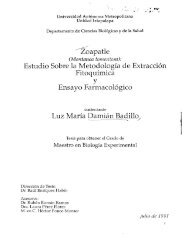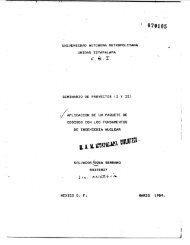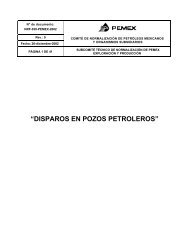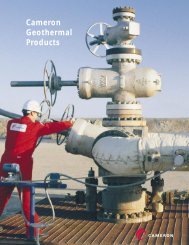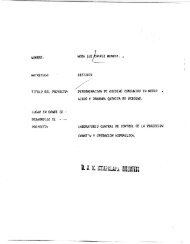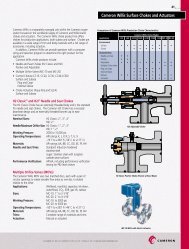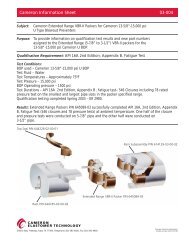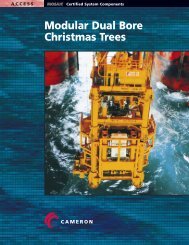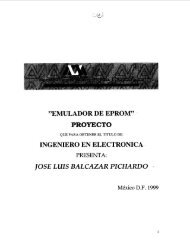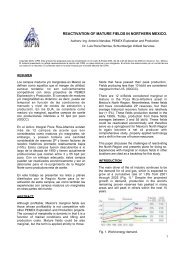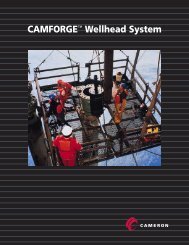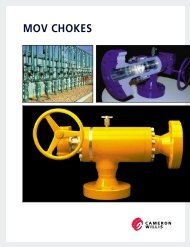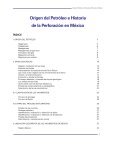Técnicas Especiales de Perforación - cedip
Técnicas Especiales de Perforación - cedip
Técnicas Especiales de Perforación - cedip
Create successful ePaper yourself
Turn your PDF publications into a flip-book with our unique Google optimized e-Paper software.
Expansión <strong>de</strong>l mercado<br />
Todos los nuevos <strong>de</strong>sarrollos en estas tecnologías, han<br />
fomentado el interés <strong>de</strong> las compañías petroleras por<br />
<strong>de</strong>sarrollar campos en aguas profundas y ultraprofundas.<br />
Como resultado, el mercado ha crecido masivamente<br />
en un periodo relativamente corto, creando<br />
nuevas oportunida<strong>de</strong>s <strong>de</strong> <strong>de</strong>sarrollo, al mismo tiempo<br />
que muchas <strong>de</strong> las operaciones convencionales<br />
costa fuera han ido <strong>de</strong>creciendo.<br />
Los hechos hablan por sí mismos. En 1998, existían<br />
cerca <strong>de</strong> 28 campos en aguas con tirantes <strong>de</strong> agua<br />
mayores a los 500 m alre<strong>de</strong>dor <strong>de</strong>l mundo, produciendo<br />
conjuntamente alre<strong>de</strong>dor <strong>de</strong> 935 mil b/día. De<br />
acuerdo a un reporte confiable, tan sólo las reservas<br />
recuperables totales <strong>de</strong> esos mismos campos eran <strong>de</strong><br />
8 mil 400 millones <strong>de</strong> barriles. Aún más importante, las<br />
reservas mundiales <strong>de</strong> yacimientos <strong>de</strong>scubiertas en aguas<br />
profundas son <strong>de</strong> casi 43 mil millones <strong>de</strong> barriles con una<br />
ten<strong>de</strong>ncia a ser <strong>de</strong> 100 mil millones <strong>de</strong> barriles.<br />
AGUAS PROFUNDAS<br />
<strong>Técnicas</strong> <strong>Especiales</strong> <strong>de</strong> <strong>Perforación</strong><br />
Estas cifras son impresionantes y nos muestran que<br />
los <strong>de</strong>sarrollos en aguas profundas no son una frontera<br />
irreal, sino que representan el futuro <strong>de</strong> la industria<br />
costa fuera.<br />
Hace veinte años, la perforación costa fuera no<br />
enfrentaba problemas como la corriente cíclica y<br />
los flujos en aguas someras que provocan gran<br />
impacto en el éxito y los costos <strong>de</strong> la exploración<br />
y <strong>de</strong>sarrollo <strong>de</strong> campos en aguas profundas. Todo<br />
parece indicar que la nueva actividad <strong>de</strong> perforación<br />
en aguas ultraprofundas enfrentará, <strong>de</strong> igual<br />
manera, nuevos problemas. Pero la industria se<br />
beneficiará mejorando la seguridad y compartiendo<br />
nuevas experiencias.<br />
En las tablas 5, 6 y 7 se muestran algunas cifras relevantes<br />
relacionadas con los <strong>de</strong>sarrollos en aguas profundas.<br />
Pronóstico <strong>de</strong> campos produciendo en aguas profundas entre 1998-2004<br />
Año<br />
Golfo <strong>de</strong> México<br />
(USA)<br />
Brasil<br />
Africa<br />
Occi<strong>de</strong>ntal<br />
Lejano<br />
Oriente<br />
Resto <strong>de</strong>l<br />
Mundo<br />
Total<br />
1998 16 11 0 0 1 28<br />
1999 26 13 0 0 1 40<br />
2000 35 15 2 0 2 54<br />
2002 45 18 8 3 4 78<br />
2004 53 21 12 5 5 96<br />
Fuente: Deepwater Oil & Gas Monthly/SREA<br />
Tabla 6.<br />
Tabla 5.<br />
Estimación <strong>de</strong> reservas mundiales probadas y probables en aguas profundas (MMBls)<br />
Golfo <strong>de</strong> México<br />
(USA)<br />
América<br />
<strong>de</strong>l Sur<br />
Africa<br />
Occi<strong>de</strong>ntal<br />
Lejano<br />
Oriente<br />
Antártida Otros<br />
Probadas 6,500 17,000 8,500 8,000 - 3,500<br />
Probables<br />
Fuente: SREA<br />
12,000 15,000 15,000 21,000 18,000 5,500<br />
Tabla 7.<br />
Porcentaje <strong>de</strong> campos futuros por método <strong>de</strong> <strong>de</strong>sarrollo<br />
Prof. (m) 300 350 400 450 500 600 700 800 900 1,000 1,500 2,000 2,500<br />
Plataformas 7 5 7 0 0 15 0 0 0 0 0 0 0<br />
Plat. y equipo submarino 0 5 0 0 0 0 0 0 9 10 0 0 0<br />
<strong>Perforación</strong> <strong>de</strong> Alcance<br />
Extendido<br />
Sistemas flotantes <strong>de</strong><br />
0 0 0 0 0 0 0 0 0 0 0 0 0<br />
producción y<br />
almacenamiento (FPS)<br />
50 55 86 25 50 62 71 83 73 90 91 100 100<br />
Plat. y FPS 7 0 0 0 0 0 0 0 0 0 0 0 0<br />
Sistemas submarinos a<br />
plataformas<br />
36 30 7 75 50 23 14 17 18 0 9 0 0<br />
Fuente: Douglas-Westwood’s World Deepwater Report<br />
41



